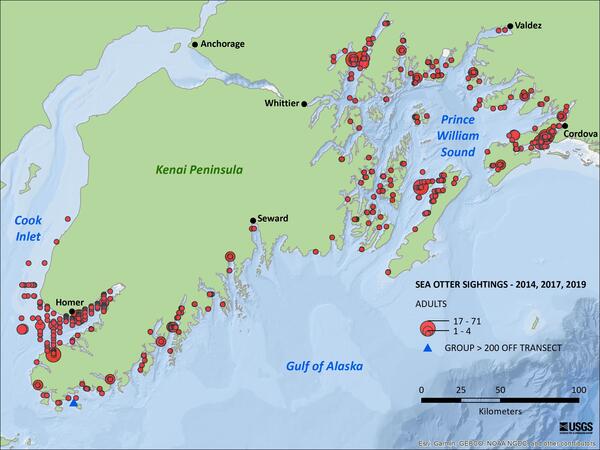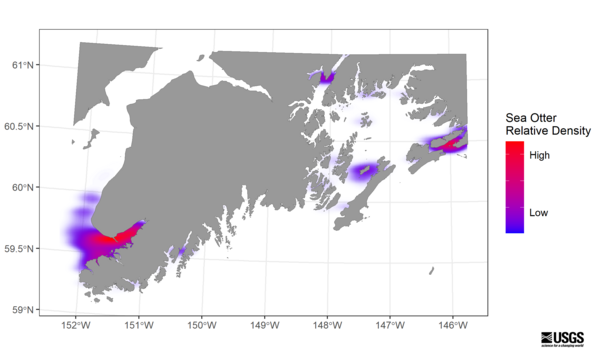Distribution map of sea otters in southcentral Alaska from aerial surveys flown in 2014, 2017, and 2019.
George G Esslinger
Using new technologies to study ecosystems; sea otter ecology; geographic information systems; population estimation; predator/prey interactions.
Professional Experience
1998 - Present Zoologist, USGS, Alaska Biological Science Center Anchorage, Alaska
1995 - 1998 Fish and Wildlife Biologist, USGS, Alaska Biological Science Center Anchorage, Alaska
1993 - 1995 Biological Science Technician, U.S. Fish & Wildlife Service, Alaska Fish & Wildlife Research Center Anchorage, Alaska
1989 - 1993 Biological Science Technician, U.S. Fish & Wildlife Service, Migratory Bird Management Anchorage, Alaska
Education and Certifications
M.S. 2011 University of Alaska, Anchorage, AK Biological Sciences
B.S. 1993 Humboldt State University Arcata, CA Wildlife
Science and Products
SeeOtter: Improving software for AI-assisted processing of imagery for wildlife surveys
Nearshore Marine Ecosystem Research
USGS Research Vessel Alaskan Gyre
Sea Otter Aerial Survey Data from lower Cook Inlet and the outer Kenai Penisula, Alaska, 2002
Sea Otter Aerial Survey Data from Western Prince William Sound, Alaska, 2022
Glacier Bay National Park and Preserve Sea Otter Forage Data, 1993-2019
Intertidal Temperature Data from Kachemak Bay, Prince William Sound, Katmai National Park and Preserve, and Kenai Fjords National Park
Intertidal Mussel (Mytilus) Data from Prince William Sound, Katmai National Park and Preserve, and Kenai Fjords National Park
Intertidal and Subtidal Sea Otter Prey Sampling in Mixed Sediment Habitat in Glacier Bay National Park and Preserve, Alaska, 1998 to 2011
Sea Otter Aerial Survey Data from Lower Cook Inlet, Alaska, 2017
Sea Otter Aerial Survey Data from Western Prince William Sound, Alaska, 2017
Sea Otter Aerial Survey Data from the outer Kenai Peninsula, Alaska, 2019
Sea Otter Aerial Survey Data from Northern and Eastern Prince William Sound, Alaska, 2014
Sea Otter Survey Data, Carcass Recovery Data, and Blood Chemistry Data from Southwest Alaska
Morphometric and Reproductive Status Data for Sea Otters Collected or Captured in Alaska

Distribution map of sea otters in southcentral Alaska from aerial surveys flown in 2014, 2017, and 2019.

Density estimate of sea otters in southcentral Alaska from aerial surveys flown in 2014, 2017, and 2019. Sea otters in southcentral Alaska are the northernmost stock of sea otters and a keystone predator because they are known for structuring nearshore marine ecosystems through their feeding habits. Biologists with the USGS and USFWS conducted aerial
Density estimate of sea otters in southcentral Alaska from aerial surveys flown in 2014, 2017, and 2019. Sea otters in southcentral Alaska are the northernmost stock of sea otters and a keystone predator because they are known for structuring nearshore marine ecosystems through their feeding habits. Biologists with the USGS and USFWS conducted aerial
A layout illustration of the R/V Alaskan Gyre deck.
A layout illustration of the R/V Alaskan Gyre deck.

The R/V Alaskan Gyre in Katmai National Park, Alaska
The R/V Alaskan Gyre in Katmai National Park, Alaska
The dynamics of sea otter prey selection under population growth and expansion
Understanding sea otter population change in southeast Alaska
Informing management of recovering predators and their prey with ecological diffusion models
Nearshore ecosystems in the Gulf of Alaska
Revealing the extent of sea otter impacts on bivalve prey through multi-trophic monitoring and mechanistic models
Northern Sea Otter (Enhydra lutris kenyoni) population abundance and distribution across the southeast Alaska stock, summer 2022
Where land and sea meet: Brown bears and sea otters
Abundance and distribution of sea otters (Enhydra lutris) in the southcentral Alaska stock, 2014, 2017, and 2019
Diffusion modeling reveals effects of multiple release sites and human activity on a recolonizing apex predator
Sea otter population collapse in southwest Alaska: Assessing ecological covariates, consequences, and causal factors
Sea otter (Enhydra lutris) populations in southwest Alaska declined substantially between about 1990 and the most recent set of surveys in 2015. Here we report changes in the distribution and abundance of sea otters, and covarying patterns in reproduction, mortality, body size and condition, diet and foraging behavior, food availability, health profiles, and exposure to environmental contaminants
Trends and carrying capacity of sea otters in Southeast Alaska
The rise of an apex predator following deglaciation
Science and Products
SeeOtter: Improving software for AI-assisted processing of imagery for wildlife surveys
Nearshore Marine Ecosystem Research
USGS Research Vessel Alaskan Gyre
Sea Otter Aerial Survey Data from lower Cook Inlet and the outer Kenai Penisula, Alaska, 2002
Sea Otter Aerial Survey Data from Western Prince William Sound, Alaska, 2022
Glacier Bay National Park and Preserve Sea Otter Forage Data, 1993-2019
Intertidal Temperature Data from Kachemak Bay, Prince William Sound, Katmai National Park and Preserve, and Kenai Fjords National Park
Intertidal Mussel (Mytilus) Data from Prince William Sound, Katmai National Park and Preserve, and Kenai Fjords National Park
Intertidal and Subtidal Sea Otter Prey Sampling in Mixed Sediment Habitat in Glacier Bay National Park and Preserve, Alaska, 1998 to 2011
Sea Otter Aerial Survey Data from Lower Cook Inlet, Alaska, 2017
Sea Otter Aerial Survey Data from Western Prince William Sound, Alaska, 2017
Sea Otter Aerial Survey Data from the outer Kenai Peninsula, Alaska, 2019
Sea Otter Aerial Survey Data from Northern and Eastern Prince William Sound, Alaska, 2014
Sea Otter Survey Data, Carcass Recovery Data, and Blood Chemistry Data from Southwest Alaska
Morphometric and Reproductive Status Data for Sea Otters Collected or Captured in Alaska

Distribution map of sea otters in southcentral Alaska from aerial surveys flown in 2014, 2017, and 2019.
Distribution map of sea otters in southcentral Alaska from aerial surveys flown in 2014, 2017, and 2019.

Density estimate of sea otters in southcentral Alaska from aerial surveys flown in 2014, 2017, and 2019. Sea otters in southcentral Alaska are the northernmost stock of sea otters and a keystone predator because they are known for structuring nearshore marine ecosystems through their feeding habits. Biologists with the USGS and USFWS conducted aerial
Density estimate of sea otters in southcentral Alaska from aerial surveys flown in 2014, 2017, and 2019. Sea otters in southcentral Alaska are the northernmost stock of sea otters and a keystone predator because they are known for structuring nearshore marine ecosystems through their feeding habits. Biologists with the USGS and USFWS conducted aerial
A layout illustration of the R/V Alaskan Gyre deck.
A layout illustration of the R/V Alaskan Gyre deck.

The R/V Alaskan Gyre in Katmai National Park, Alaska
The R/V Alaskan Gyre in Katmai National Park, Alaska
The dynamics of sea otter prey selection under population growth and expansion
Understanding sea otter population change in southeast Alaska
Informing management of recovering predators and their prey with ecological diffusion models
Nearshore ecosystems in the Gulf of Alaska
Revealing the extent of sea otter impacts on bivalve prey through multi-trophic monitoring and mechanistic models
Northern Sea Otter (Enhydra lutris kenyoni) population abundance and distribution across the southeast Alaska stock, summer 2022
Where land and sea meet: Brown bears and sea otters
Abundance and distribution of sea otters (Enhydra lutris) in the southcentral Alaska stock, 2014, 2017, and 2019
Diffusion modeling reveals effects of multiple release sites and human activity on a recolonizing apex predator
Sea otter population collapse in southwest Alaska: Assessing ecological covariates, consequences, and causal factors
Sea otter (Enhydra lutris) populations in southwest Alaska declined substantially between about 1990 and the most recent set of surveys in 2015. Here we report changes in the distribution and abundance of sea otters, and covarying patterns in reproduction, mortality, body size and condition, diet and foraging behavior, food availability, health profiles, and exposure to environmental contaminants





